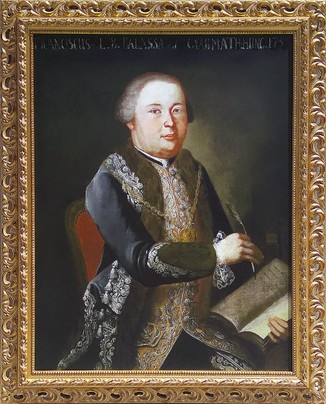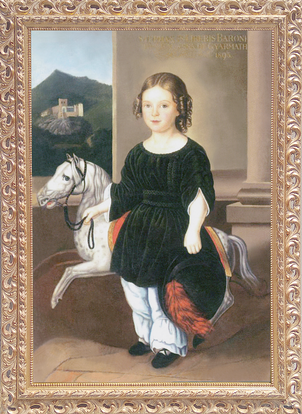THE FAMILY BALAŠA IN THE TIME OF ENLIGHTENED REFORM | ||
In the first half of the 16th century, the reformation of the German countries also spread to Slovakia and, due to the political disintegration after the Battle of Mohacs, civil war and the weakened Catholic Church, it spread very quickly. Just like the anti-Habsburg uprisings, it also polarised society and undermined the concerted action against the expansion of the Ottoman Empire. The Hungarian nobility was in jeopardy, and yet insisted on maintaining their privileges and share of power. The tense atmosphere between the Hungarian nobility and the Imperial Court had ultimately grown into open conflicts – the mentioned anti-Habsburg uprisings against the centralisation efforts of the Vienna Habsburg Court and for the preservation of aristocratic privileges. The fight took place mostly on the territory of present-day Slovakia, which was the core of the fraction of the Hungarian Kingdom that had left after the Ottoman invasion in the 16th century. The rebels, in their desire to break free from the bondage of the Austrian monarchy, associated even with the greatest enemy – the Ottoman Empire or the anti-Habsburg clusters in other parts of Europe. The uprising had severe consequences for the economic and social life of the country. | ||
PAVOL II. BALAŠA (1699 – 1770) | ||
 | ||
The eldest son of Gabriel Balaša (1642 – 1700) and Mária Peréni. He studied at the Jesuit Gymnasium in Trenčín. In 1733, he completed the rebuilding of the ancestral castle in Orlové in the Baroque style. He was elected director of the ancestral holdings. On April 15, 1721, King Charles III granted him a countship. In 1730, following a fire, he rebuilt the lower part of the Renaissance-Gothic castle of Modrý Kameň as a Baroque Manor House. In 1751, he became an Imperial Chamberlain, Councillor of the Hungarian Governing Council and governor of Gemer County (1740 – 1770). His first wife was Katalin Zichy. With his second wife Júlia Batthyány (1715 – 1807), he had sons Ján and Jozef. For his service to the Imperial Crown and his conduct in high offices which he held in the service of the Habsburg sovereign Maria Theresa, his family resided at the castles of Modrý Kameň and Bratislava, where he, in 1762 completed the construction of a representative palace (today the Palace of Balassa at Panská street, Bratislava). He was one of the most significant Catholic aristocrats in Bratislava and a person enjoying the trust of the sovereign. Concerning the Catholic Reformation efforts of the Habsburgs, he was an eager supporter of the return of the reformed to the Catholic Church. In 1739, he was appointed special commissioner of the so-called Pre-Danube Region and director of the provincial commissioners in charge of supervising the supply and payment of taxes to the Crown. During the 2nd Prussian War (1744), he stood at the head of the noble troops of Gemer in the service of the Empress. After his death, his son Ján became Counsellor of the Governing Council and governor of Gemer County, but he soon died without leaving offspring (1772). With his death, the 3rd line of counts of the genus Balaša died out. As a member of the Hungarian Governing Council, Count Pavol II Balaša was the organizer and supporter of activities in favour of the return of the renegades into the bosom of the Catholic Church. His support for the Catholic Reformation efforts of the Habsburgs was represented also in the construction of sacral buildings – churches, chapels and parishes. He was a confessor of the cult of St. Anne, who was the patron of the genus. An interesting thing is that he died on the day of St. Anne, on July 26, 1770. For his loyalty and support of the Catholic faith in these difficult times of Catholic Reformation, Pope Benedict XIV (1740 – 1758) granted him the title of the “apostolic count”. At the same time, the Pope gave him a relic – the mummified body of St. Felician. The relic was originally deposited at the Modrý Kameň castle and later ceremonially transferred to Balašské Ďarmoty and, on August 20, 1759 it was deposited in the Church of St. Trinity at the 5th altar donated to the Church by Pavol Balassa, at the same time as the ordination of the church. The authenticity of the relic was confirmed by Bishop Anton Révay, who also ordained it. The detailed description of the festivity has been preserved in archive documents. In 1759, he built the Chapel of St. Anne at the Modrý Kameň castle. It was ordained a few days after the celebration of St. Felician and the Church of St. Trinity in Balašské Ďarmoty by Bishop Anton Révay. The preserved Baroque reliquary of St. Anne found in the Modrý Kameň parish in 2009 (250th anniversary of the chapel) was the second reliquary owned by count Pavol II. Balaša. The main altar painting in the chapel was not preserved. In 2009, it was substituted with artwork by the academic painter Darina Gladišová. From 1732, count Pavol II. Balaša lived with his second wife, countess Julia Batthyány of Güssing (1714/1715 – 1807). Since she was from the family of Esztergom Archbishop Cardinal József Batthyány (1772 – 1799), she too might be given credit for founding the Calvary. Therefore, the Calvary was founded, as most of the European Calvary’s, during the times of Baroque and strong Catholic Reformation efforts of the Church. It was situated in the forest covering the tufa rock right opposite the entrance to the castle. It had eight Stations of the Cross and the Baroque Chapel of Crucifixion was opened towards the surrounding space. The pilgrimages were held on the feast of the Holy Rosary, always on the first Sunday in October and organised by the local Rosary Guild supported by the count Pavol II. Balaša. After his death, the guild ceased to exist and the Calvary started to crumble. After his death, his son Ján became a councilor of the Governing Council and the chief mayor of Gemer, but he almost died without leaving any descendants (1772). She died of him III. Count branch of the genus Balaša. | ||
FRANTIŠEK III. BALAŠA (1736 – 1807) | ||
 | ||
He was one of the most prominent members of the genus of Balassa. He was born in the castle of Modrý Kameň and spent most of his life there. He served in a high position in the contemporary social and political life and won the recognition of Empress Maria Theresia and Emperor Joseph II. He was a Counsellor of the Governing Council, President of the Hungarian Chamber, Master of the Treasury and Guardian of the Crown. In 1785, he became Croatian-Dalmatian Ban. He supported the Enlightenment Reforms of both monarchs. His religious attitudes leaned towards tolerance. In 1788, he refused to assume the patronage over the Catholic community of Modrý Kameň. In 1772, Empress Maria Theresia granted him the title of Count including the right to use the initials of her name (MT) in his ancestral coat of arms. His significant literary works include political disputation, scientific studies on the reformed system of education, in which he advocated for the development and support of national languages. He spent the last years of his life in seclusion in his ancestral holdings. He died childless in the Castle of Modrý Kameň on August 28, 1807 and was buried in the crypt of the Catholic Church of St. Nicholas in Veľké Zlievce. With his death, the 4th line of counts of the genus of Balaša died out. | ||
ALEXANDER BALAŠA (1745 – 1823) Son of Ladislav Balaša (1700 – 1746) spent a part of his life in the castle of Modrý Kameň. He was most probably buried on the local historical cemetery, which had been used as the town´s burying ground till the late 19th century and then it gradually ceased to be used. His youngest daughter Alojzia, who died in 1824 at the age of two, was also buried there. In the cemetery, there are several preserved graves of the family members of his third wife Anna Kišová (1805 – 1856, Modrý Kameň), with whom he had five children. Some sources indicate that she was the daughter of the administrator of the castle estate. All these circumstances including the retained ancestral coat of arms on the monument on the crypt in the cemetery suggest the Alexander Balaša was buried in the crypt and the nearby tombs are the graves of the other members of his family. Alexander Balassa held high functions in the Royal Court. | ||
ANTON BALAŠA (1822 – 1877) Son of Alexander Balaša was born in the castle of Modrý Kameň. He left his mark in the history of the castle by renewing the Baroque Calvary in 1855, extending it with the Chapel of Sorrowful Mother, the central painting of which was made by an artist from Budapest, and a new Station of the Cross. He donated land for the construction of the temple of St. Anthony of Padua and financially generously supported the building of the first school in Modrý Kameň.In the early period of monument preservation and protection in the Austrian Empire, he engaged in collecting, history and archaeology. He was a corresponding member of the Imperial Royal Commission for the Preservation of Architectural Monuments. He initiated the foundation of the Economic Society of Novohrad County, joined in by the nobility of the surrounding estates and in 1859, he became its chairman. However, he did not develop and raise the status of his own estate and ultimately brought it to auction. Afterwards he left the country and in 1877 died in Switzerland. Out of his four sons, only Alexander (1850 – 1899) and Štefan (1845 – 1895) reached adulthood. Neither of them, however, attempted to save the ancestral castle and estate of Modrý Kameň. Anton was the last member of the genus who lived in the castle of Modrý Kameň. With the death of Alexander III, the male line of the genus of Balaša died out. For a short time, the castle estate of Modrý Kameň was owned by Count Anton Forgáč. | ||
ŠTEFAN BALAŠA (1845 – 1895) | ||
 | ||
„Stephanus Liberis Baronibus Balassa de Gyarmath et Kékkö 1845 – 1895“ | ||
Štefan Balaša was a member of the Balaša dynasty, who definitely lost the castle of Modrý Kameň. We know that he mostly lived in manors of his wife in north-east Hungary (nowadays east Slovakia), but he didn’t achieve a higher social or political position in his live. His brother Alexander was the lastmale member of the Balaša dynasty from Gyarmat and Kékkó. On the other side – how the Blue stone castle got to the Forgách dynasty is still a subject of research. | ||
EMMA BALAŠOVÁ (1872 – 1936) | ||
The last descendant of the genus of Balaša (after Štefan) was his daughter Emma Balaša (1872 – 1936), who married František Rágali. At that time, the archive, the gallery and the treasury of the family had already been moved from the indebted estate of the castle of Modrý Kameň to Nižný Hrabovec to the property of Štefan’s wife Helena Péterffi. In 1902, František Rágali received the consent for the association of two family coats of arms. At the same time, he became the Baron of Ragali-Balaša from Čoltovo, Balažské Ďarmôt and Modrý Kameň. However, no male descendant came from this last branch of the genus and the genus Ragali-Balaša is definitively extinguished. Archive and monuments of the Balaša family from the manor in Ragáli during World War II. got lost. Historians are constantly searching for them. | ||
Go to content
Back to content


